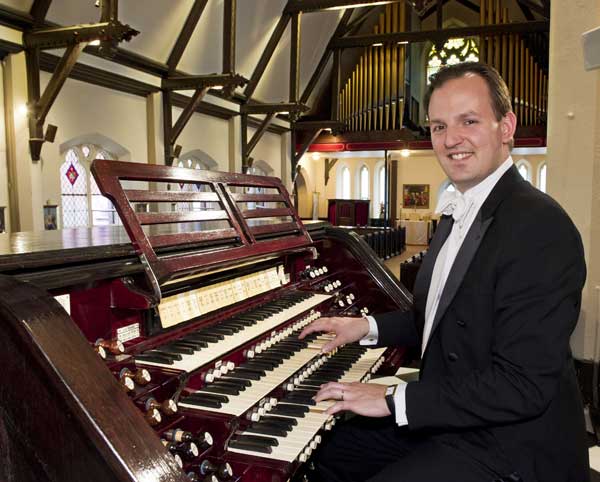Organist Enlow serves up a brief but dazzling program
César Franck, it has been said, made a distinctive impression while seated at the organ. His playing, his students recalled, was angelic, an attribute that led to his unique nickname, Pater Seraphicus.
The composer’s majestic style was reflected in one of his longest works for organ, the Grande Pièce Symphonique. Colorful and as spectacular as its title implies, the piece is a cathedral in sound.
That work was the centerpiece of a wide-ranging program of French, German, and Norwegian music heard in organist David Enlow’s remarkable, if brief, recital at Boston’s Church of the Advent Saturday afternoon.
Enlow, organist and choir master at New York’s Church of the Resurrection and a faculty member at the Juilliard School, commands a dazzling technique at the organ console. His interpretations were clear, affecting, and cradled in enveloping warmth that emanated from the instrument he played that afternoon, an Aeolian-Skinner organ from 1936.
The instrument at the Church of the Advent has a distinctive tone quality. Refurbished with new pipes in 2006, the ranks sound with a rich velvety blend from its silvery flutes to its cooing reeds. The organ’s trumpet pipes are penetratingly clear and seem to sound down upon the listeners from high above.
Those aspects were made manifest in Enlow’s rendition of the Grande Pièce Symphonique. The first movement opened with rolling, silver-laced lines. The low rumble of a bass melody soon dominated the musical texture with Enlow handling the phrases between the organ’s triple manuals and pedals with ease.
The second movement featured fanfare calls over a sinewy web of running figures. Elsewhere, in Enlow’s hands, whiffs of melody floated above the texture as if an improvisation.
The organist also gave the reverential phrases of the third movement a free flowing feel as he gently layered the melodies upon themselves. Enlow, all the while, took care to bring out the ebbing and flowing inner lines of the music.
The finale, perhaps the most famous of the movements, unfolded in fragmented statements that were unsettled by wandering chromaticism. Faint echoes of melody swelled into robust statements through slow crescendos that culminate in powerful, rafter-shaking chords. Through it all, Enlow played with aplomb.
The organist has stated that his approach to such music combines the musicological exactitude of historical performance with a freedom to interpret the original source material. His synthetic vision was clearest in the three pieces that rounded out Saturday’s recital: Enlow’s own transcriptions for organ of orchestral and piano works.
The opener, Johan Strauss II’s overture to Die Fledermaus, captured the symphonic scope, pulsing polkas, and lilting waltzes of the orchestral original. Enlow handled the filigree that peppers this beloved score with grace. He rendered the waltz with an exaggerated rubato, capturing, to good effect, the Viennese style.
Two movements from Edvard Grieg’s Holberg Suite followed. Enlow’s transcriptions owe as much to the composer’s romantic tone colors as to the Baroque forms upon which these pieces are based. The Prelude rolled in gentle waves, with the murmur of the organ’s flute ranks soaring over the trickling lines. The Sarabande was soft and alluring, the great powers of the Aeolian-Skinner harnessed for hushed tones. In both, Enlow played with tender and sensitive touch.
The recital concluded with two selections from Debussy’s Petite Suite. The four-hand piano work has been transcribed numerous times for various ensembles. Yet Enlow’s transcription is a fresh, crisp and colorful setting with an instrumental palette that recalls Henri Büsser’s orchestral version. His “En bateau” involved a silvery melody over a gently bubbling accompaniment. “Ballet,” also heard Saturday afternoon, featured the lightly piercing sound of the trumpet ranks. Enlow handled the music’s dancing lines with dexterity.
Posted in Performances




